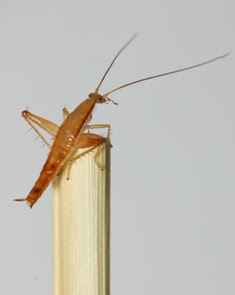Table Mountain Leaproach Hits Top-10 List
The World's only known jumping cockroach, discovered in the Table Mountain National Park by Prof. Mike Picker (University of Cape Town) and Dr. Jonathan Colville (Applied Biodiversity Research Division, SANBI) has just leapt into the Top 10 New Species for 2011! The list is compiled by the International Institute for Species Exploration at Arizona State University in the US and highlights the most exciting species described taxonomically in 2010.
Top 10 New Species
'Leaproach', as Picker and Colville have named it, was described in 2010 and given the name Saltoblattella montistabularis, which loosely translates to "small jumping cockroach from Table Mountain". It joins on the Top 10 list a leech with enormous teeth, an iron-oxide consuming bacterium discovered on a rusticle from the RMS Titanic, a flat-as-a-pancake batfish that appears to hop along the ocean floor, and a six-foot-long fruit-eating lizard.
Collected from: Table Mountain Leaproach Hits Top-10 List
Top 10 - 2011 | International Institute for Species Exploration
Name: Saltoblattella montistabularis
Common Name: Leaproach
Family: Blattellidae
How it made the Top 10: This new species of cockroach exhibits unusual morphology. It has legs that are highly modified for jumping. Prior to its discovery jumping cockroaches were only known from the Late Jurassic. This extant cockroach has jumping ability that is on par with grasshoppers. In addition to the leg modifications, it has hemispherical shaped eyes that protrude from the sides of the head instead of kidney shaped and the antennae have an additional fixation point to help stabilize them during jumping.
Collected from: Top 10 - 2011 | International Institute for Species Exploration
Unique creature
Speaking of their latest find, Picker said: “We were sweep netting and saw something that at first looked like a grasshopper, but when we got it back to the laboratory it became clear it was a cockroach, closely related to the common roach but with sophisticated hind legs and the ability to jump many times its own height.”
The leaproach measures a modest centimetre in length, and looks like a cross between a cockroach, a cricket and a grasshopper. Its Latin name is derived from Saltoblattella which means jumping small cockroach, while montistabularis refers to the place it was discovered.
Colville said: “Superficially it resembled a cricket, but not quite.”
The leaproach shares certain features with grasshoppers - large muscular hind legs for jumping; bulging eyes; toes that allow them to grip before and after jumping; and a strengthened antennae base which supports the delicate appendages during jumping.
Collected from: New bug leaps into history books - MediaClubSouthAfrica.com
Related
- Sunday AI: Leaping Cockroaches - Skepchick
- 68_1_Bohn_53-69.pdf (application/pdf Object)
- Saltoblattella Montistabularis, Jumping Cockroach, Found In South Africa's Table Mountain National Park
- Jumping Jiminy cockroach! Discovery of world's only LEAPING roach thrills scientists (and makes others wince) | Mail Online


